
Johann Bernhard Fischer von Erlach was an Austrian architect, sculptor, and architectural historian whose Baroque architecture profoundly influenced and shaped the tastes of the Habsburg Empire. His influential book A Plan of Civil and Historical Architecture (1721) was one of the first and most popular comparative studies of world architecture. His major works include Schönbrunn Palace, Karlskirche, and the Austrian National Library in Vienna, and Schloss Klessheim, Holy Trinity Church, and the Kollegienkirche in Salzburg.
Johann Ernst Eberlin was a German composer and organist whose works bridge the baroque and classical eras. He was a prolific composer, chiefly of church organ and choral music. Marpurg claims he wrote as much and as rapidly as Alessandro Scarlatti and Georg Philipp Telemann, a claim also repeated by Leopold Mozart - though ultimately Eberlin did not live nearly as long as either of those two composers.
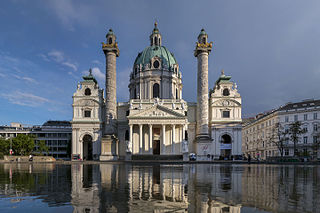
The Rektoratskirche St. Karl Borromäus, commonly called the Karlskirche, is a Baroque church located on the south side of Karlsplatz in Vienna, Austria. Widely considered the most outstanding baroque church in Vienna, as well as one of the city's greatest buildings, the church is dedicated to Saint Charles Borromeo, one of the great counter-reformers of the sixteenth century.

Johann Lukas von Hildebrandt was an Austrian baroque architect and military engineer who designed stately buildings and churches and whose work had a profound influence on the architecture of the Habsburg Empire in the eighteenth century. After studying in Rome under Carlo Fontana, he constructed fortresses for Prince Eugene of Savoy during his Italian campaigns, becoming his favorite architect. In 1700 he became court engineer in Vienna, and in 1711 was named head of the court department of building. He became court architect in 1723. His designs for palaces, estates, gardens, churches, chapels, and villas were widely imitated, and his architectural principles spread throughout central and southeast Europe. Among his more important works are Palais Schwarzenberg, St. Peter's Church, and Belvedere in Vienna, Savoy Castle in Ráckeve, Schönborn Palace in Göllersdorf, and Schloss Hof.

Salzburg Cathedral is the seventeenth-century Baroque cathedral of the Roman Catholic Archdiocese of Salzburg in the city of Salzburg, Austria, dedicated to Saint Rupert and Saint Vergilius. Saint Rupert founded the church in 774 on the remnants of a Roman town, and the cathedral was rebuilt in 1181 after a fire. In the seventeenth century, the cathedral was completely rebuilt in the Baroque style under Prince-Bishop Wolf Dietrich von Raitenau to its present appearance. Salzburg Cathedral still contains the baptismal font in which composer Wolfgang Amadeus Mozart was baptized.
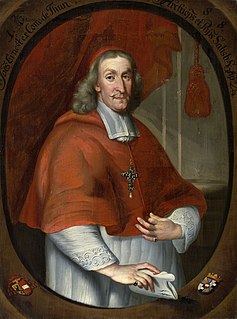
Johann Ernst Graf von Thun und Hohenstein was Bishop of Seckau from 1679 to 1687 and Prince-archbishop of Salzburg from 1687 until his death.

Joseph Emanuel Fischer von Erlach, also Fischer von Erlach the younger was an Austrian architect of the Baroque, Rococo, and Baroque-Neoclassical.
The year 1707 in architecture involved some significant events.
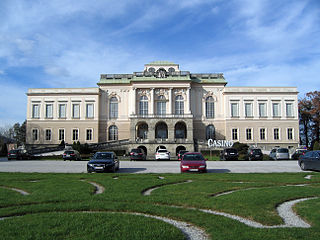
Schloss Klessheim is a Baroque palace located in Wals-Siezenheim, 4 km (2.5 mi) west of Salzburg, Austria. The palace was designed and constructed by Austrian architect Johann Bernhard Fischer von Erlach for Prince-Archbishop Johann Ernst von Thun in 1700. It became the summer residence of the Archbishops of Salzburg. Since 1993, the palace has been used by Salzburg Casino.

Herzogenburg Monastery is an Augustinian monastery located in Herzogenburg in Lower Austria. Founded in 1112 by Augustinian Canons, the monastery was refurbished in the Baroque style in 1714 by Jakob Prandtauer, Johann Bernhard Fischer von Erlach, and Josef Munggenast.

Mirabell Palace is a historic building in the city of Salzburg, Austria. The palace with its gardens is a listed cultural heritage monument and part of the Historic Centre of the City of Salzburg UNESCO World Heritage Site.
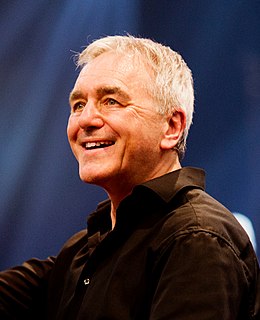
Howard Arman is an English choral conductor and opera director. He won the Handel Prize of the Handel Festival, Halle, in 1996, shaped the festival's orchestra and conducted operas of George Frideric Handel. He is a conductor of the Theater and Philharmonie Thüringen, also the Luzerner Theater. Since 2017 he is the Director of the Bayerische Rundfunk Chor.

The Felsenreitschule is a theatre in Salzburg, Austria and a venue of the Salzburg Festival.

The Haus für Mozart is a theatre in Austria. It is one of the venues of the Salzburg Festival in the city of Salzburg. Since 1925, it was the first venue for the festival and was originally known as the Festspielhaus. With the opening of the Großes Festspielhaus in 1960 it was renamed the Kleines Festspielhaus, and in 2006 it gained its current name. Mainly, operas and concerts are staged there.

The Holy Trinity Church is a Roman Catholic church in Salzburg, Austria. It was designed by Johann Bernhard Fischer von Erlach.

The Franciscan Church is one of the oldest churches in Salzburg, Austria. The church is located at the intersection of Franziskanergasse and Sigmund-Haffner-Gasse opposite the Franciscan Friary in the Altstadt section of the city. The first church on this site was erected in the eighth century. Between 1408 and 1450, a Gothic choir replaced the Romanesque choir. A slender Gothic tower was added between 1468 and 1498. The church was dedicated to the Virgin Mary and served as the parish church until 1635. It was ceded to the Franciscan Order in 1642. Johann Bernhard Fischer von Erlach redesigned the church interior in the baroque style in the eighteenth century.

The Winter Palace of Prince Eugene, also known as the City Palace, is a high-Baroque palace in the Innere Stadt district of Vienna, Austria. Located on a narrow street at Himmelpfortgasse 8, the palace was used as the winter residence of Prince Eugene of Savoy, who spent his summers at the Belvedere. The Winter Palace was designed and constructed by Johann Bernhard Fischer von Erlach from 1695 to 1700, and by Johann Lukas von Hildebrandt from 1702 to 1724 following his predecessor's plans.
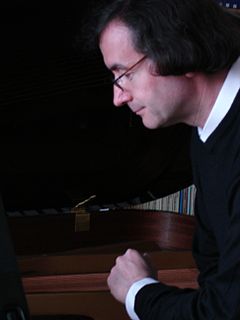
Ludger Stühlmeyer is a German cantor, composer, docent and musicologist.

The church St. Stephan is a Catholic church in Baden in Lower Austria. The official name is Stadtpfarrkirche St. Stephan. The present building began in Gothic style in the 15th century. It was remodeled Baroque in the 17th century, and an attempt made to restore Gothic features from 1880.

Franz Anton von Harrach zu Rorau was appointed coadjutor of Vienna and Titular Bishop of Epiphania in Syria in 1701, was from 1702 to 1705 Prince-Bishop of Vienna, 1705 coadjutor of Salzburg, and ruled from 1709 to 1727 as one of the most important Prince-Archbishops of Salzburg.























